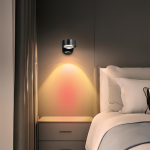Lighting plays a crucial role in interior design, as it has the power to transform the mood and atmosphere of a space. When it comes to the dining room, proper lighting design is especially important, as it can enhance the dining experience and create a welcoming and inviting ambiance. In this article, we will explore the different aspects of kensulighting dining room lighting design, including the types of fixtures, choosing the right bulbs, positioning the fixtures, layering the lighting, creating a focal point, using dimmer switches, incorporating natural light, and final tips for perfecting your dining room lighting design.
Key Takeaways
- Proper lighting in the dining room is crucial for creating a comfortable and inviting atmosphere.
- There are various types of dining room lighting fixtures, including chandeliers, pendant lights, and wall sconces.
- Choosing the right bulbs for your dining room lighting can impact the mood and ambiance of the space.
- Positioning your dining room lighting fixtures strategically can enhance the overall design and functionality of the room.
- Layering your dining room lighting with different fixtures and dimmer switches can create a dynamic and versatile space.
The Importance of Proper Lighting in the Dining Room
Proper lighting in the dining room is essential for creating the right mood and atmosphere. Whether you are hosting a formal dinner party or enjoying a casual meal with your family, the lighting can greatly impact the overall experience. Soft and warm lighting can create a cozy and intimate ambiance, while bright and cool lighting can make the space feel more energetic and lively. By choosing the right lighting fixtures and bulbs, you can set the tone for your dining room and create a space that is both functional and aesthetically pleasing.
Types of Dining Room Lighting Fixtures
There are several types of lighting fixtures that can be used in the dining room to achieve different effects. Chandeliers are a popular choice for dining rooms, as they can add elegance and sophistication to the space. Pendant lights are another option that can provide focused task lighting over the dining table. Wall sconces can be used to create ambient lighting and add visual interest to the walls. Recessed lights are a versatile option that can be used to provide general illumination or highlight specific areas of the room. Finally, table lamps or floor lamps can be used to add additional lighting and create a cozy atmosphere.
Choosing the Right Bulbs for Your Dining Room Lighting
| Factors to Consider | Recommended Bulbs |
|---|---|
| Color Temperature | 2700K-3000K |
| Brightness | 800-1100 lumens |
| Dimming Capability | LED bulbs with dimming feature |
| Fixture Type | Candelabra bulbs for chandeliers, A19 bulbs for pendant lights |
| Energy Efficiency | LED bulbs with Energy Star certification |
Choosing the right bulbs for your dining room lighting is crucial, as it can greatly impact the quality and color of the light. There are several types of bulbs available, including incandescent, halogen, fluorescent, and LED. Incandescent bulbs are the traditional choice and provide a warm and soft light. However, they are not as energy-efficient as other options and have a shorter lifespan. Halogen bulbs are similar to incandescent bulbs but are more energy-efficient and have a longer lifespan. Fluorescent bulbs are energy-efficient and have a long lifespan, but they can produce a harsh and cool light. LED bulbs are the most energy-efficient option and have a long lifespan. They are available in a variety of colors and can be dimmed to create different moods.
Positioning Your Dining Room Lighting Fixtures
Proper placement of lighting fixtures is essential for achieving the desired lighting effect in the dining room. When it comes to chandeliers or pendant lights, they should be centered over the dining table and hung at a height that allows for comfortable conversation without obstructing the view. Wall sconces should be placed at eye level to provide even illumination throughout the room. Recessed lights should be evenly spaced to provide general illumination, with additional fixtures placed strategically to highlight specific areas or objects. Table lamps or floor lamps should be placed in corners or on side tables to provide additional lighting and create a cozy atmosphere.
Layering Your Dining Room Lighting for Maximum Effect

Layering lighting in the dining room involves using different types of fixtures to create depth and dimension. By combining ambient, task, and accent lighting, you can achieve a balanced and visually appealing lighting design. Ambient lighting provides overall illumination and can be achieved through chandeliers, pendant lights, or recessed lights. Task lighting focuses on specific areas or objects and can be achieved through wall sconces or table lamps. Accent lighting highlights specific features or objects and can be achieved through recessed lights or spotlights. By layering these different types of lighting, you can create a dynamic and inviting atmosphere in your dining room.
Creating a Focal Point with Your Dining Room Lighting
Lighting can be used to create a focal point in the dining room, drawing attention to a specific area or object. This can be achieved through the use of a statement chandelier or pendant light that becomes the centerpiece of the room. Alternatively, you can use accent lighting to highlight a piece of artwork or a decorative element in the room. By creating a focal point with your lighting, you can add visual interest and create a sense of drama in your dining room.
Using Dimmer Switches to Control Your Dining Room Lighting
Dimmer switches are a great addition to any dining room lighting design, as they allow you to control the intensity and mood of the lighting. By adjusting the dimmer switch, you can create a soft and intimate ambiance for a romantic dinner or increase the brightness for a lively gathering. Dimmer switches also help to save energy and extend the lifespan of your bulbs. When using dimmer switches, it is important to choose bulbs that are compatible with dimming, such as LED bulbs.
Incorporating Natural Light into Your Dining Room Design
Incorporating natural light into your dining room design has several benefits. Natural light can make the space feel more open and spacious, as well as provide a connection to the outdoors. It also helps to enhance the colors and textures in the room, creating a more vibrant and inviting atmosphere. To maximize natural light in your dining room, consider using sheer curtains or blinds that allow light to filter through while still providing privacy. You can also position mirrors strategically to reflect natural light and make the space feel brighter.
Final Tips for Perfecting Your Dining Room Lighting Design
To perfect your dining room lighting design, consider the following tips:
– Choose fixtures and bulbs that complement the style and decor of your dining room.
– Use a mix of lighting fixtures to create depth and dimension.
– Position fixtures at the right height and angle to provide optimal illumination.
– Experiment with different lighting levels and dimmer settings to create the desired mood.
– Incorporate natural light whenever possible to enhance the overall ambiance.
– Regularly clean and maintain your lighting fixtures to ensure they are functioning properly.
– Consider consulting with a professional lighting designer for expert advice and guidance.
By following these tips and considering the different aspects of dining room lighting design, you can create a space that is both functional and visually appealing. Whether you are hosting a formal dinner party or enjoying a casual meal with your family, the right lighting can greatly enhance the dining experience and create a warm and inviting atmosphere.
If you’re looking to enhance the ambiance of your dining room, lighting plays a crucial role. In fact, the right lighting can completely transform the look and feel of your space. If you’re unsure where to start, check out this informative article on Dining Room Lighting from Art is Home Gallerie. It provides valuable insights and tips on how to choose the perfect lighting fixtures for your dining area. From chandeliers to pendant lights, this article covers it all. So, whether you’re aiming for a cozy and intimate atmosphere or a bright and modern vibe, this article will guide you in creating the perfect lighting scheme for your dining room.


